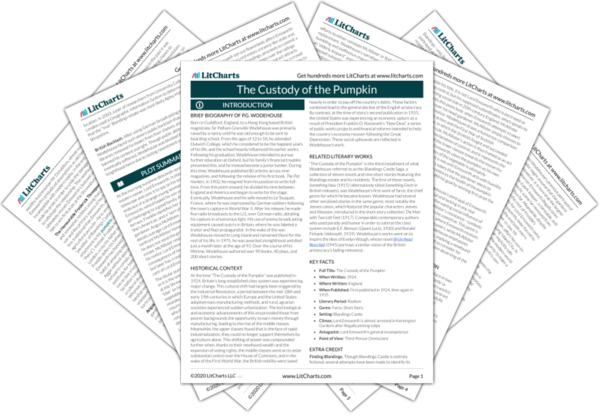Welcome to the LitCharts study guide on P.G. Wodehouse's The Custody of the Pumpkin. Created by the original team behind SparkNotes, LitCharts are the world's best literature guides.
The Custody of the Pumpkin: Introduction
The Custody of the Pumpkin: Plot Summary
The Custody of the Pumpkin: Detailed Summary & Analysis
The Custody of the Pumpkin: Themes
The Custody of the Pumpkin: Quotes
The Custody of the Pumpkin: Characters
The Custody of the Pumpkin: Symbols
The Custody of the Pumpkin: Theme Wheel
Brief Biography of P.G. Wodehouse

Historical Context of The Custody of the Pumpkin
Other Books Related to The Custody of the Pumpkin
- Full Title: The Custody of the Pumpkin
- When Written: 1924
- Where Written: England
- When Published: First published in 1924, then again in 1935
- Literary Period: Realism
- Genre: Farce, Short Story
- Setting: Blandings Castle
- Climax: Lord Emsworth is almost arrested in Kensington Gardens after illegally picking tulips.
- Antagonist: Lord Emsworth’s general incompetence
- Point of View: Third-Person Omniscient
Extra Credit for The Custody of the Pumpkin
Finding Blandings. Though Blandings Castle is entirely fictional, several attempts have been made to identify its location. In 2003, a pair of researchers from University College London used a Geographic Information System to determine that the “true” Blandings estate was most likely Apley Hall in Shropshire.
British Backlash. After using German broadcasting equipment, Wodehouse faced such severe public backlash that several libraries removed his books from their shelves, and the BBC banned his content outright. Though public attitudes eventually softened, Wodehouse was blocked from receiving a knighthood twice due to lasting resentment over the issue.












